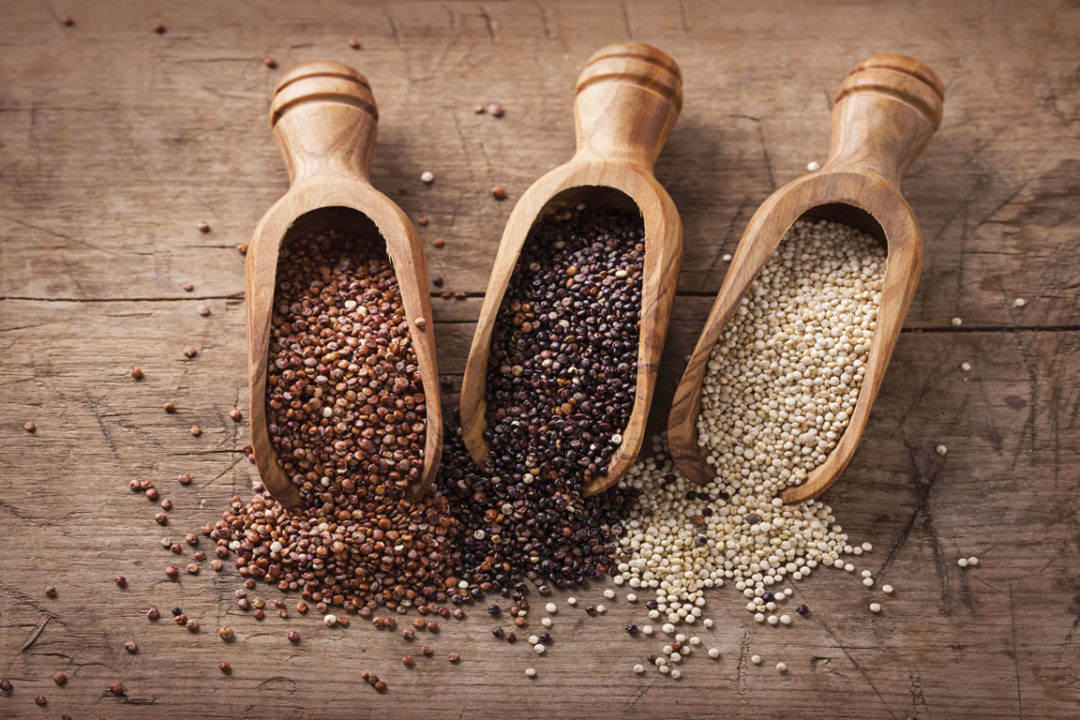Most consumers may be familiar with whole grains but fairly recently, ancient grains and sprouted grains have entered their nomenclature, adding another layer to how people make decisions about purchasing flours, breads and other baked goods. Ancient and sprouted grains have certain advantages nutritionally as well as greater tolerability for those with certain sensitivities and allergies. Of course, not all ancient and sprouted grains are created equal and customers will need guidance from you to clear up misconceptions as well as understand which grains will best serve their needs.
Ancient GrainsWhile wheat has been and will likely remain a staple grain in the mainstream, more health conscious consumers are turning away from modern wheat toward ancient grains. “Modern wheat has been bred extensively over the past 70 year and is quite different from the wheat humans have been eating for millennia,” explains Tara Blyth, director of communications and development for Kamut International, Ltd, Missoula, MT. “Ancient grains have not been affected by intensive commercial breeding programs and are closer to what our bodies recognize as nourishing food.”
More broadly speaking, ancient grains, as well as sprouted grains, are considered whole grains. Whole grains are defined by the Boston, MA-based Whole Grain Council (WGC) as a grain that retains its three original parts; the bran, germ and endosperm. By contrast, refined grains such as white flour have their bran and germ removed, leaving only the endosperm. “This means that they offer the health benefits of whole grains, including a lower risk of heart disease, stroke, and type-2 diabetes,” says Kelly Toups, MLA, RD, LDN program director, WGC. “When grains are refined (by removing the bran and germ), they lose about 25% of their protein, and are greatly reduced in at least 17 essential nutrients, including fiber.”
While there is no official definition of ancient grains, WGC defines them loosely as grains that have been largely unchanged for several hundred years. Many grains can fall under the banner of ancient grains including einkorn, emmer/farro, Kamut, spelt, sorghum, teff, millet, quinoa and amaranth. Heirloom varieties of more common grains can also fall under the banner such as black barley, red and black rice and blue corn, says WGC.
Nutrition.Seeing as ancient grains are whole grains, they retain their nutritional value, offering a more complete spectrum of nutrients. While not an ancient grain, compared to whole wheat flour for example, refined wheat flour has lower nutrition content and more calories. Even enriched wheat flour only enchances the flour’s thiamin, riboflavin, niacin, iron and folate values while everything remains lower and calories remain high. Ancient grains for their part, offer even more unique nutrient profiles.
“Teff, amaranth and quinoa are relatively rich in calcium, contributing about 60 mg per 4 ounce serving,” explains Sue Gray, director of research and development for Norwich, VT-based King Arthur Flour. “Amaranth and quinoa contribute a complete amino acid profile, having more lysine than wheat. Barley is higher in fiber than some of the other grains.”
Quinoa in particular has become an enormously popular ancient grain, whose nutrition consumers have placed a great value on, with an emphasis on protein. Dr. Micheal Koziol, the director of quality for Inca Organics, Athens, GA explains that quinoa’s protein value is superior to other grains but elaborates furtherabout its amino acid profile and lysine content. These factors, he says, not only contribute to the grain’s protein content but more importantly, its quality.
“Essential amino acids are those which the body either cannot synthesize or cannot synthesize in sufficient quantities to meet the needs for growth and/or maintenance,” Koziol explains. “Each protein source will have an amino acid which is found in shortest supply and thus is known as the limiting amino acid, which in turn limits protein synthesis. Lysine is the common limiting amino acid in cereals, but quinoa is extraordinarily rich in lysine. Adding 20% quinoa flour to wheat flour increases the lysine content by 48%.”
This means that the less lysine, the less protein synthesis and the more lysine, the more protein synthesis in the body. In addition, quinoa has a higher lipid content that is about double that of wheat. “Its fatty acid profile, similar to that of soybean oil, is particularly rich in unsaturated fatty acids, especially omega-6,” says Koziol. “A 100g portion of cooked quinoa would provide about 5% of the RDA of omega-6 for adolescents and adults. Further, these lipids are resistant to oxidation due to the high concentrations of the antioxidants alpha- and gamma-tocopherol.”
Other grains like Kamut, which is a brand name for a strain of wheat called khorasan, has scientific research behind its health benefits. For example, research done in three phases, led by researchers in Italy compared the antioxidant properties of breads made from whole grain modern durum wheat and whole grain Kamut khorasan wheat and how they affected the response to oxidative stress in rats. Phase one found that khorasan wheat breads had significantly higher total polyphenols, particularly Selenium than modern wheat (1).
Furthermore, after seven weeks of experimental diets, rats were then subjected to exogenous oxidative stress. Results showed that although both the whole grain modern wheat and whole grain khorasan wheat were good sources of antioxidants, the khorasan wheat group had a better response to stress, particularly the sourdough variety (1).
Phase two utilized the same diet and scientific approach, with results that agreed with phase one of the research. However, this time researchers found higher levels of activity of liver antioxidant enzymes in those rats that consumed khorasan wheat breads, which could be attributed to khorasan’s higher Selenium content (2). Phase three of this research dives even deeper. This time, feeding rats pasta instead of bread, the study confirmed the previous data about antioxidant protection, but also found that 48 hours after inducing oxidative stress and 12 hours of fasting, rats fed whole wheat pasta saw inflammation in several tissues and organs, while khorasan-fed rats showed normal cell and tissue characteristics (3). Even control rats that ate the whole wheat pasta showed inflammation despite not receiving exogenous oxidative stress.
Researchers observed that this resembled the effects of non-celiac wheat sensitivities, which are reactions to wheat without the pathology of celiac disease. The fact that the khorasan wheat did not create inflammation in control rats and protected against oxidative stress and inflammation in experimental rats is significant for human consumers. “The hypothesis of the presence of anti-inflammatory agents is supported by the higher content of specific antioxidant components in the Kamut pasta, whose role can be related not only to the prevention of oxidative stress but also to an anti-inflammatory action,” write the researchers (3).
Gluten.This gets us into one of the most important factors consumers consider when purchasing ancient grain products as well as the greatest misconception; gluten status. “Contrary to popular belief, gluten free doesn’t mean grain free,” says Toups. “In fact, many whole grains are naturally gluten free, including quinoa, millet, teff, amaranth, buckwheat, wild rice, brown rice, and corn.”
However, this is not true of all ancient grains, as they are not free of wheat, barley, rye or their derivatives. What contributes to the misconception that ancient grains are gluten free is that some are exceptionally tolerable to those with wheat allergies. The Kamut study described previously demonstrates how a modern and ancient strain of wheat can differ significantly from each other in their composition as well as the way they affect the body, despite containing gluten.
“A lot of people who have problems with gluten can eat Kamut Brand wheat and other ancient grains without any negative health effects. Because of this phenomenon they believe that Kamut khorasan is gluten free or that it has less gluten,” says Blythe. “That is not the case...Our medical research has demonstrated many properties that we believe contribute to Kamut wheat being better tolerated — lack of pesticides, more resistant starch, anti-inflammatory properties, high-levels of antioxidants.”
Einkorn is another form of wheat that has not undergone the hybridization of modern wheat and therefore is profoundly different explains Daniel Davenport, vice president of operations, To Your Health Sprouted Flour Co., Fitzpatrick, AL. “Einkorn is an ancient grain that contains gluten, but when tested with an Eliza gluten strip, it will provide a negative result, which is a testament to the original state of this ancient grain,” he says.
This, of course, does not mean that ancient grains with gluten should be recommended to those diagnosed with Celiac Disease. While certain gluten-containing ancient grains may be tolerable to those with non-celiac wheat sensitivities, it would be wise for such a customer to confirm with a doctor before proceeding to eat grains like Kamut or einkorn. However, if someone is simply trying to improve their diet and try something different, ancient grains with gluten might be a good place to start before they jump on the gluten-free train.
Sprouted GrainsSprouted grains are not new, but the growth of consumer interest is a relatively new phenomenon. Therefore, many customers may be unfamiliar with what sprouted grains exactly are. There is currently no regulated definition of sprouted grains but quite simply, they are whole grains that have begun to sprout and are therefore straddling the line between seed and new plant (4). So, what’s the point of this?
“Sprouted grains have increased nutrition and are more bio-available to our bodies,” explains Davenport. “The sprouting process brings dormant vitamins and minerals in grains to life as well as breaks down the grains’ natural protective barrier, making them easier to digest without our stomachs having to do the hard work.”
This is supported by scientific research. Toup cites a 2013 study published in Food Chemistry that mirrors the Kamut research mentioned previously. In the study, antioxidant activity is compared between white rice, brown rice and sprouted brown rice in hyperlipidaemic rabbits. The study concludes, “[sprouted brown rice] supplementation has the greatest impact on increasing antioxidant enzyme activity and vitamin E level” (5).
“Similarly, Vietnamese researchers found that sprouted wheat was higher in dietary fiber, free amino acids and phenolic compounds than unsprouted wheat,” explains Toup. “More recently, a 2014 study found that dietary fiber content increased (6.1-13.6%) with sprouting time and temperature across six different varieties of brown rice “ (6,7).
Regarding bioavailability, Toup cites another study that examined how sprouting finger millet, wheat and barley influenced the bioavailability of iron, zinc, calcium and copper (8). Results showed that in sprouted millet, iron had a more than three-fold increase in bioavailability while sprouted wheat showed a two-fold improvement. Zinc’s bioavailability improved by 234% and 100% in sprouted wheat and barley, respectively. And finally, sprouting improved the bioavailability of manganese in millet by 17% and wheat by 42% (8).
It should also be noted that just as there are gluten and gluten-free ancient grains, sprouting grains does not change the gluten content. So make sure customers who are avoiding gluten understand that the same rules apply.
Consumer Demand and PopularityAstute retailers recognize buying patterns among their customers and keeps their ear to the ground for growing trends. So many have already been taking notice of the increased consumer interest in ancient and sprouted grains. But as natural products continue to move into the mainstream and consumers take a greater interest in their health, you are likely to continue seeing this growth.
According to Chicago, IL-based SPINS, ancient grains have been showing immense sales growth. Their data shows that non-gluten free ancient grains like Kamut and spelt have shown 686% and 363% growth, respectively and gluten-free varieties like amaranth, teff and quinoa have shown 123%, 58% and 35% growth, respectively (SPINSscan Natural and Specialty Gourmet, proprietary, SPINSscan Conventional, powered by IRI, 52 weeks ending 7/13/2014) (9). Gluten intolerance, as mentioned before is a major factor for many consumers and has resulted in a 29% increase in grains claiming gluten-free status on their packaging as well as acquiring Gluten-Free Certification. At the same time, these products saw sales growth, barley and wheat saw a decline of 3.1% and 9.4%, respectively.
“Ancient and sprouted grains have become increasingly popular in part because of the unprecedented national attention that has been given to food and nutrition over the past eight years, as well as the growing culinary curiosity of the average consumer,” says Toup. “Thanks to the school lunch changes, cooking shows, and the growing popularity of meal kit delivery services and food blogs, consumers are embracing new cuisines and ingredients.”
She explains that chefs are the early adopters of this trend toward ancient and sprouted grains, and the National Restaurant Associations Culinary Forecast has moved ancient grains to its #14 spot in 2017. This culinary exposure will spark consumer interest and pursuit of ancient or sprouted grains in everyday life. “While whole wheat and oats were the predominant source of whole grains in packaged goods for many years, we are increasingly seeing products made with teff, amaranth, sorghum, and millet,” details Toup. “In fact, a 2015 report from market research firm Packaged Facts, found that nearly a fifth (19%) of American adults have purchased menu or grocery items with ancient grains in the past 30 days (the same percentage also report purchasing sprouted grain products).”
“These two trends mirror each other because consumers’ motivations are similar — they are looking for new products that are viewed as healthier, less refined, more nutritious and taste good,” explains Mattison Crowe, brand manager at King Arthur Flour. People are naturally curious and as they continue to explore this category in the interest of better health, what began as a trend will become regular practice.
Inspiring the Home BakerWhile there are many finished product manufacturers that currently produce goods that utilize ancient and sprouted grains, many health conscious consumers want to also be able to make better-for-you baked goods at home. Doing so can be a bit tricky but manufacturers of flours made from ancient and sprouted grains want to make the change as painless as possible.
“Because whole grains have different functional properties than refined grains, they cannot always be substituted one-for-one using the same process,” says Toup. “Different grains have different cooking times, different moisture requirements, and different flavor affinities.”
While adjustments are necessary, they are relatively simple. For example, “In recipes calling for whole wheat flour, you can replace it 1-for-1 with King Arthur Sprouted Wheat Flour,” says Crowe. “For recipes that call for all-purpose or bread flour, we recommend replacing up to 50 percent with our sprouted wheat flour.” When converting the recipe entirely to whole grain wheat, Toup recommends “an additional 2 teaspoons of liquid per cup of whole wheat flour, as whole grains tend to absorb more moisture.”
This advice can be useful in converting a recipe to sprouted grains as well. And while other whole grain products may not offer as much flavor, sprouted grains are advantageous “for their pleasant taste, especially in baking,” says Toup. “As Master Baker Peter Reinhart described at our 2014 whole grains conference, the sprouting process preconditions the grain to give up its full flavor, meaning that sprouted grains are often sweeter and much lighter tasting than their non-sprouted counterparts.”
Another advantage of sprouted grains says Davenport, “is the enzymatic action that is produced during the sprouting stage that reduces the need to knead a bread dough and reduces the proofing time of bread doughs. This advantage can be a big money-saver to commercial bakers and a big time-saver to the home baker.”
Ancient grains such as Kamut also demand more water. “Some preliminary research from the San Francisco Baking institute suggest it needs 20-30% more liquid than conventional flour,” says Blythe. “However, once that work is done, the benefits are numerous, a sweet, buttery flavor, a satisfying texture, a beautiful golden color plus all of the health benefits.”
There are also bound to be numerous resources for finding excellent ancient and sprouted grain recipes, however if someone wanted to convert their favorite recipes, adding more or less water to the mix isn’t a monumental change, though it may take some trial and error to get it just right. The real challenge is with gluten-free ancient and sprouted grains.
“Gluten helps give structure to baked goods, so if you’re working with a gluten-free ancient grain (such as quinoa flour or teff flour), you’re not going to get the same rise or texture that you’d get from a wheat flour product by just substituting one-for-one,” says Toup. This is where finding a gluten free-specific recipe would be ideal.
The reason this is good to know as a retailer is because curious customers may be intimidated by utilizing new ingredients and if you could ease their worries, they’ll be more willing to try one or more new ingredients on your shelves. Share recipes and cross-merchandise modern wheat products with ancient and sprouted grain varieties to spark interest.WF
References1. A. Gianotti, et al. “Role of cereal type and processing in whole grain in vivo protection from oxidative stress.” Front Biosci (Landmark Ed). 16:1609-18. 2011.
2. S. Benedetti, et al. “Counteraction of oxidative damage in the rat liver by an ancient grain (Kamut brand khorasan wheat).” Nutrition. 28(4):436-41. 2012.
3. A. Carnevali, et al. “Role of Kamut® brand khorasan wheat in the counteraction of non-celiac wheat sensitivity and oxidative damage.” Food Research International. 2014. http://www.sciencedirect.com/science/article/pii/S0963996914000829. Accessed 1/2/2017.
Published in WholeFoods Magazine February 2017









